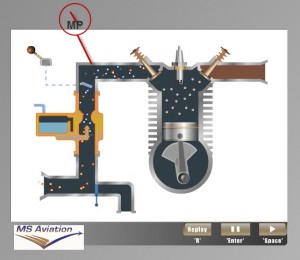Why does manifold pressure increase during a prop check?
This is a follow-up question to an earlier post entitled “What is Manifold Pressure ?”
You might also see this question printed in the August 2009 issue of Downwind Magazine. Ask a CFI will be a regular contributor to this exciting new aviation publication. So keep your flight training questions coming because there is a good chance you might now see your question (and the answer) in print!
David submitted a question recently asking:
In a constant speed propeller piston aircraft, when doing a magneto check, the RPM will drop and the manifold pressure will rise slightly. This is because the engine is developing less power without both magnetos firing two spark plugs in each cylinder. We understand why the RPM drops with less engine output but why does the manifold pressure rise?
To start, you need to completely re-think your previous knowledge of the manifold pressure gauge. Because, as flight and ground instructor John Deakin of Advanced Pilot likes to say, the manifold pressure gauge is about suction not pressure! (Read his article “Manifold Pressure Sucks“)
Think of your engine and cylinders as one big vacuum pump. Every time a cylinder drops into the intake stroke, it is literally sucking air through the filter, past the throttle plate, and across manifold pressure gauge. Your manifold pressure gauge is actually reading the amount of vacuum that is being developed in the intake manifold as the air is being pulled into the cylinders. That’s why at idle power with the throttle plate closed the manifold pressure gauge reads 12 or 13 inches when atmospheric pressure is 30 inches. Your engine is literally starving for air! With the throttle plate partially closed (it never fully closes) there is a vacuum created in the intake manifold of your engine.
Here is a good internal image of an aircraft engine. You can see here the intake stroke where the piston is litterally pulling the fuel / air mixture into the cylinder. This image was taken from a flash animation producted by MS Aviation. They have a whole assortment of flash animations for pilots and instructors. I inserted the crudely drawn manifold pressure gauge.
When you reduce the RPM during a magneto check or even better during a prop check you are slowing the engine down and reducing the “sucking power” of the cylinders. Because you haven’t moved the throttle plate (using the throttle), the manifold pressure gauge moves UP towards ambient outside air pressure. In fact, if you have ever done any multi-engine flight training, you’ll notice that when you feather a prop (thereby reducing the engine to 0 RPM) the manifold pressure does not go to 0 but in fact it rises to, yep, you guessed it, ambient pressure (or very close to it). So that is why your manifold pressure gauge rises during a prop check!
Thanks for your question David and remember…
Fly Safe!
Aviation Flash Animations courtesy of MS Aviation. Aviation Flash Animations
John Deakin offers Advanced Pilot Training Seminars. You can visit Advanced Pilot.com for more information.



Patrick Flannigan on Jul 25, 2009
Excellent question, and an equally excellent answer. I suggest everybody follow that link to Deakin’s article. He really brings the point home.
Capt.Ng`humbu Ntiga on May 03, 2013
It is a wonderful explanation, thanks Paul Tocknell
Alex Buder , MD on Nov 15, 2017
When you say ” every time a cylinder drops into the intake stroke ” , don’t you mean ” every time a piston drops into the intake stroke “??
Erik on Sep 25, 2023
Thank you for this explanation, it has helped a lot!